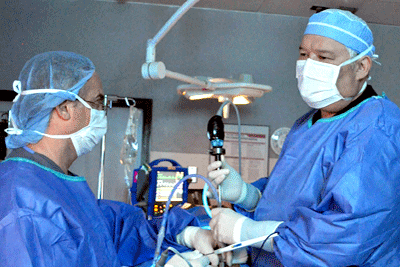Developments in treating spine conditions are occurring at an ever increasing rate. Most new technologies and procedures involve reducing post-operative pain, speeding recovery, and preserving motion in the spine (as opposed to immobilizing the spine with fusion spine surgeries, which require large incisions, and long recovery times). But buyer beware: often the new technologies being promoted are more of a marketing tool for physicians than a true advancement in patient outcomes.
Physicians, especially those engaged in technology-intensive specialties such as surgery, play a critical role in the adoption and diffusion of new health technologies. Patients should temper their enthusiasm and be realistic about what can and cannot be accomplished. Truly useful spine treatment technologies often take years to be verified. Many technologies that once seemed to hold the promise of significant advancement in treating low-back pain have been largely or completely abandoned. They include:
- Chemonucleolysis – a non-surgical treatment for bulging discs that involves an injection to dissolve the inner portion of the disc
- Laparoscopic lumbar fusions
- Intradiscal electrothermal Coagulation (IDET) – in which a coiled wire is inserted into affected spinal discs and heated to cauterize painful nerve endings.
Where many patients are finding back pain relief with fewer complications and long-term results is through targeted minimally invasive spine surgery. These types of surgeries are defined not just by the length of the incision required – generally less than an inch – but by the relative reduction of soft tissue trauma. These surgeries have led to less blood loss during surgery, less post-operative pain, and more rapid recovery times. At the Bonati Spine Institute, patients are asked to walk within minutes of the completion of surgeries, patented as The Bonati Spine Procedures. Additionally, patients are encouraged to begin walking the next day and often resume regular activity within a week.
Spine surgery, like any other field of medicine is more of an art than a science. There are no simple answers, and relying on new technologies alone to improve outcomes is probably not going to be all that reliable. Even the best technology will not be useful if what is operated on is not what was causing your pain. True pain relief starts at the most basic level – an open and honest physician/patient relationship that leads to an accurate pre-operative diagnosis. This process begins with a series of MRI or CT Scan reports, as well as a thorough patient history. Pre-operative testing includes the measurement of blood counts, blood clotting times, an EKG, a chest X-ray and cardiac clearances. Because spine surgery is such an important decision, patients should look to surgical centers that focus exclusively on the spine and that have an established history of success in relieving pain.
If you are considering your options for spine surgery, allow the highly-skilled surgical team at the Bonati Spine Institute to review your case and discuss your options with you before you make any final decisions. Simply call 855-267-0482 to get started.

